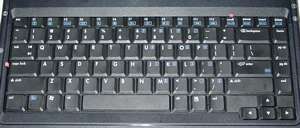HP Pavilion ZE2000
Construction: Field Tested (cont.)
|
Keyboard – The ZE2000's keyboard is similar to other keyboards we have seen from HP. The tactile feedback gives a good feel, but not as much in our opinion as HP's business end notebooks, i.e. the NC6000. However, this keyboard is probably better than the average consumer targeted notebooks. We should note that there is more of an audible "click" that can be heard when you hit keys. Some people like this and some don't, it is really a matter of preference.
The only two problems we have with the layout is, one, that the home/end/page up/page down keys are all clustered on the right hand side. While this means that you don't have to stretch your fingers to access them, you don't get the same feel for the notebook, because their placement is counterintuitive when it comes to keyboard ergonomics. "Correct" placement is debatable, but generally speaking, it should be a three by two button arrangement in the upper right hand corner. The second problem we have is that the keyboard seems spaced too close to the front. As you can see, HP has enough real estate to space it further up. The fact that they didn't might make it uncomfortable for some, if you don't like having your wrists sit close to or on the edge of the notebook.
LEDs – Other than the four LEDs placed on the front of the system and the one for the card reader, there is no secondary strip of LEDs for keyboard key status like caps lock. Instead, caps and num lock have their LEDs situated right next to the keys themselves (orange when active). (There is no LED for scroll lock.) The only other things that light up are the icons inside the power and wireless buttons (orange and blue, respectively).
TouchPad & Buttons – More recently, HP seems to be using touchpads that have good durability and good traction, and the ZE2000 continues that trend. Compared to most, the only difference is that the texture on the touchpad is made of a similar material to the black chassis, which means there is likelihood that you will wear it down. While some may find it annoying, HP uses a touchpad that has a scroll region for quick scrolling. We should note that you should be able to turn this feature off and use the "extra" width of the touchpad for more real estate in mouse movement.
As for the buttons, our qualm is that they are a bit smaller than what we would have liked to have seen. Ideally, they should be about 25% taller. The smaller than expected size shouldn't affect usage too much though. The only problem we had was that because the keyboard was situated relative far down the chassis, so was the touchpad, which may make it harder to switch between the two if you have large hands.
Speakers & Microphone – Unfortunately, there is no integrated microphone on the ZE2000, which is too bad for those that like audio messaging and the like. The only way to get a microphone up and running is to hook up one via the microphone port.
The speakers on the ZE2000 at max are loud enough so that the room one over can hear what you are listening to easily. Compared to the Dell D600, HP NC6000, and a lot of the notebooks we have seen, the quality of sound from the Harmon Kardon speakers is better than average but not the best. For example, we could hear the inflections in Keane's "Somewhere Only We Know" fairly well, but once a certain volume level was hit (~90% of max), the voice isn't as crystal clear. But this happens with most consumer end notebooks. As far as speakers go, HP did well. The best scenario would be to have the speakers right between the display, near the joint, but if they are situated in the front of the notebook, they should be angled towards you, which HP has done. This means that you should not need to raise the volume to high, since all of the audio is already directed towards your ears.












